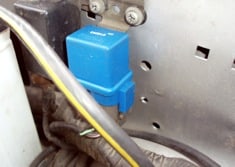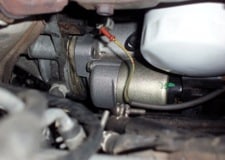Battery ratings are an essential part of testing automotive batteries and starters. The CCA is about 80% of the CA, indicating the battery is 20% less efficient at 0˚F. Modern electronic conductance testing requires a CCA rating input, as does an adjustable carbon pile load tester.
 To test the starter the battery must be fully charged. This requires three charging modes: Bulk mode: High amperage flow and low terminal voltage Does 80% of the charging).
To test the starter the battery must be fully charged. This requires three charging modes: Bulk mode: High amperage flow and low terminal voltage Does 80% of the charging).
Absorption mode: Lower amperage flow at 14.4 terminal volts. Float mode: Maintenance mode with very low amperage flow at 13.2 to 13.4 terminal volts. To reach a full state of charge (SOC), all modes must be included. Many modern battery chargers include all three modes and many PCM-based charging management strategies include similar modes. To remove the “surface charge” after the charger has been disconnected, turn on the vehicle’s headlamps for a few minutes or load the battery with a carbon pile load tester. If fully charged and in good condition, the terminal voltage should rise to 12.60 volts after a mild discharge.
Conductance testing consists of passing a mild alternating current through the battery to mea sure battery plate resistance or impedance. Plate resistance is then mathematically extrapolated into CCA. A good battery at room temperature with no electrical load should rise to about 12.60 terminal volts (full charge).
sure battery plate resistance or impedance. Plate resistance is then mathematically extrapolated into CCA. A good battery at room temperature with no electrical load should rise to about 12.60 terminal volts (full charge).
On this Pathfinder’s battery, the CCA is about 80% of the CA, which indicates that the battery is 20% less efficient at 0˚F. The difference between CA and CCA is important because modern electronic conductance testing requires a CCA rating input, as does the old-school adjustable carbon pile load tester. For illustration, three 60 month warranty batteries of the same brand were tested. To verify the conductance tests, an adjustable carbon pile load test was also conducted.
The difference between CA and CCA is important because modern electronic conductance testing requires a CCA rating input, as does the old-school adjustable carbon pile load tester. For illustration, three 60 month warranty batteries of the same brand were tested. To verify the conductance tests, an adjustable carbon pile load test was also conducted.
Battery A, rated at 540 CCA and with a purchase date of March 2002, had the terminal voltage rise to only 12.44 volts after a 48-hour float charge: About 75% of normal charge. This battery would likely crank in warm weather, but would likely fail in sub-freezing weather.
New battery B, is rated at 550 CCA with a replacement date of June 2012. A conductance test indicates 615 CCA or 111% of the rated CCA. Terminal voltage is 12.6 volts, indicating a full charge and an impedance of 5.22m ohms. The carbon pile test values were 270 amps for 15 seconds while maintaining 9.7 volts at the battery terminals. Battery C, rated at 500 CCA, has been in daily service since January 2011. Conductance testing indicates 640 CCA, or 128% of the rated CCA, with a plate impedance of 5.0m ohms. A carbon pile load test at 250 amps for 15 seconds produced 9.7 volts at the battery terminals.
10-year-old battery A was damaged by plate sulfation, caused by disuse and a continuous low SOC. Like all new  batteries, battery B produces well over its rated CCA. Similarly, battery C has been driven for about 18 months and still produces 128% of its rated CCA.
batteries, battery B produces well over its rated CCA. Similarly, battery C has been driven for about 18 months and still produces 128% of its rated CCA.
 Although modern engine starters are generally permanent-magnet, reduction-gear designs, many older vehicles are equipped with field coil starters. To illustrate, a 3.0 L V6 equipped with a permanent magnet starter in good condition was tested. Its new battery is rated at 650 CCA and tested at 842 CCA with 3.82m ohms plate impedance.
Although modern engine starters are generally permanent-magnet, reduction-gear designs, many older vehicles are equipped with field coil starters. To illustrate, a 3.0 L V6 equipped with a permanent magnet starter in good condition was tested. Its new battery is rated at 650 CCA and tested at 842 CCA with 3.82m ohms plate impedance.
The initial battery voltage was 12.51 volts and at a 50-amp draw, the voltage dropped to 12.15 volts. The average cranking voltage was 11.28 volts, with the minimum at 11.16 volts. The maximum initial cranking amperage was 161.0 amperes with an average of 114 amperes during a 7-second extended cranking test.
Next, a 2.8 L V6 equipped with a field coil starter in good condition was tested. The battery had been in service 18 months, rated at 500 CCA, and tests at 640 CCA with an impedance of 5.00m ohms. Initial voltage was 12.48 volts and, after a 50-amp load, dropped to 12.10 volts. The average cranking voltage was 10.87 volts with the minimum at 10.84 volts. Maximum cranking amperage was 205.0 amps and the average was 180 amps during a 7-second extended cranking test.
In conclusion, the field coil starter was drawing nearly 150% more amperage than the permanent magnet starter. Note: the larger engine displacements and higher compression ratios will increase cranking amperage. Most important, neither minimum cranking voltage fell below 10.0 volts. Only a battery and starter in good condition will maintain the high cranking voltages needed to maintain a full range of PCM functions.
Tips from:https://www.knowyourparts.com